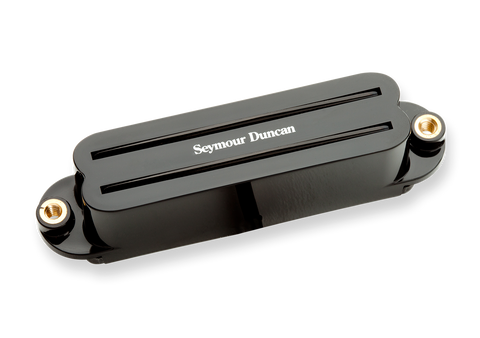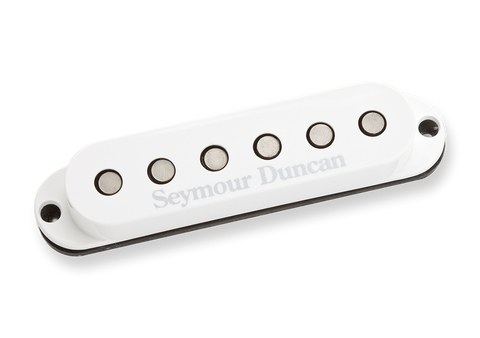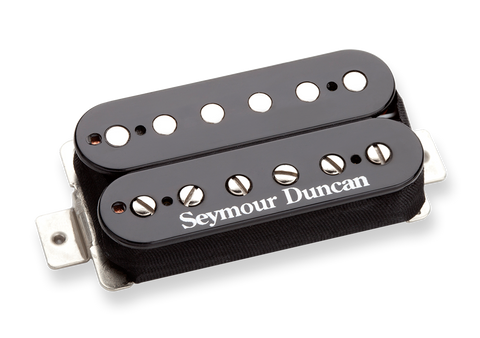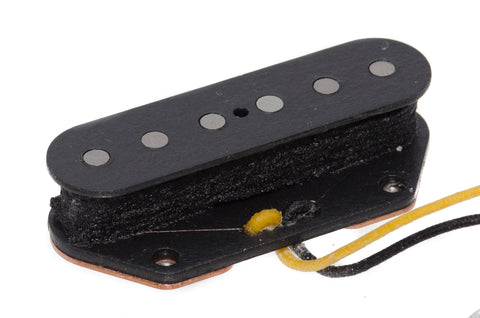From the manufacturer:
application
Warm, moderate-output humbucker. Great for jazz, blues, classic rock and slide.
description
The Alnico 2 magnet and moderate windings yield a warm, sweet tone with more natural string vibration for great sustain. Classic rock players who get their distortion from the amp rather than the pickup love the APH-1. It allows them to back off the crunch and get beautiful clean tones with softer attack. Compared to the '59, the Alnico II Pro has a rounder sound with a spongier bass response. Comes with four-conductor hookup cable and no logo.
complete setup
Often the APH-1 is used in both neck and bridge positions. Or, in the neck with a higher output pickup like an SH-11 Custom Custom or SHPG-1b Pearly Gates for heavier rock or hotter blues sounds from the bridge position.
guitars
For brighter toned instruments. Works especially well with maple and ebony fingerboards. Also works great with hollow and semi-hollow body guitars.
available mods
Nickel or gold-plated cover. Trembucker. Seymour Duncan logo.
players
Slash / Velvet Revolver & Guns 'N Roses (neck & bridge), Michael Wilton / Queensryche (bridge), Jeff Tamelier / Tower of Power (neck), Tim Mahoney / 311 (neck), Troy Van Leeuwen / Queens of the Stone Age (neck)
Ethan's picks for best videos/sound clips:
Check out the Seymour Duncan Alnico II Pro neck pickup in this clip. Listen to its warm clean tone at 0:15. You get a really nice bell-like timbre with deep lows and rounded highs, as well as an organic sustain that resonates beautifully. Skip to 0:55 to hear the sweet blues tones you can get, with a nice honk and snap for a killer tone. Rock tones are also easy to achieve, boasting amazing definition and sustain (listen at 1:50). Even in a metal context, this pickup really holds it own, with its outstanding articulation and musical harmonics. Skip to 3:00 to hear a quick clean tone comparison between select Seymour Duncan Pickups. The Alnico II pro really excels in this area, with its glassy cleans that are rich and balanced.
The player is Darius Wave and he is playing a Mayones Setius GTM 6 guitar through a Marshall JCM 2000 head, a Cornford Roadhouse 50 head, an Orange Rockerverb head, and a Peavey 5150 II head. He is mainly using a 2x12 cab by David Laboga.
The Alnico II Pro is an amazing choice to emulate some of the classic lead tones of players like Slash. It has a moderate output that really lets you push your amp more instead of completely relying on the pickup for breakup, making it a really responsive pickup. This results in glorious clean tones with soft attack and thick and creamy leads that are warm and melodic. Skip to 0:25 to hear the bridge pickup in action. It does a great job soaring above the mix with a vibrant lead sound, boasting a spongy bass response, bright top end, and endless sustain.
The player is Marky G and he is using a '79 Les Paul Custom.
Watch from the beginning until 4:45 to hear some of the great tones from the Alnico II Pro. Beginning with cleans, the bridge (0:02 - 10) has this nice low-output sound with a lot of grit to it. The middle position (0:14 - 18) combines the twinkle of the neck pickup with the bite of the bridge for a nice blend of warmth and sparkle. The neck pickup (0:20) yields a fat humbucker clean tone with deep lows and round highs. Overall, you can get a really nice clean sound with the Alnico Pro II -- with a nice soft attack and full body. This pickup really excels with some mild gain, crunching up nicely for a classic overdriven tone with moderate output (listen at 0:50). High gain tones are also pretty strong, with great transparency and a rich, full sound (listen at 1:50). The neck pickup also has a really nice sound for creamy lead tone with bell-like timbres (listen at 3:10). For classic rock, blues, and beyond, the Alnico Pro II is a versatile pickup with a great vintage/modern sound.
The player is using a Les Paul through a D.A. Booster and a Landgraff DOD clone set to "Marsall mode" with the level set to 12, drive at 14, and tone at 15.
This clip showcases the Alnico II Pro in both a rhythm and lead application within the same mix. Power chords drive the rhythm with a nice crunch sound; the pickup doesn't get into major saturation, but it has a nice gritty breakup that is powerful and clear. The Alnico II Pro especially shines in a lead context, with a vibrant and melodic tone that soars high above the mix with airy highs and even lows. Put them both together and you have classic tones with a modern edge for a killer sound!
The player is Serge Tabachnikov and he is using a Fernandes FR55 into a Mesa Boogie Stiletto II through a 2x12 cabinet with V30's.
Check out this clip to hear the Alnico II Pro in a classic Les Paul/Marshall setup. Listen from 0:05 - 0:45 to hear a clean tone coming from the bridge pickup. It has a nice gritty sound that is bright and balanced. In the middle position (0:50- 1:25), you get the brilliance and attack from the bridge with the low-end warmth and sparkly highs from the neck for a nice twinkly tone. Listen at 1:30 to hear the neck pickup by itself, boasting a rich and full sound that makes for a great rhythm clean tone. Dial in some crunch, and you'll easily get into classic rock territory with the Alnico II Pros (listen at 2:50). Or if you want to emulate some of Slash's signature tones, kick in some high gain and shred away (5:45). With the Alnico II Pro pickups, you'll be able to get thick rhythm saturation and expressive leads for a broad pallet of tones.
The player is using an Epiphone Les Paul Zakk Wylde into a Marshall JCM 2000 DSL 100 and 1960AX cab.
Here is a look at Slash's original Appetite for Destruction recording guitar, equipped with the original Alnico II Pro humbuckers. Seymour Duncan himself is in this video describing a feedback issue that the pickup is having and walking through his procedure for fixing it. After making various measurements and removing the pickup, Seymour re-pots the pickup by dipping it in wax and agitating it. He then talks about the importance of waxing and how it works to solidify the components of the pickup to reduce unwanted feedback and noise. Pretty interesting stuff!


















